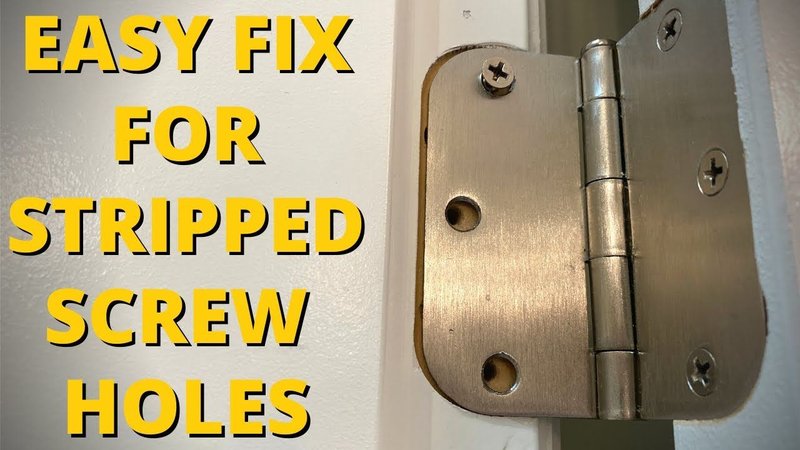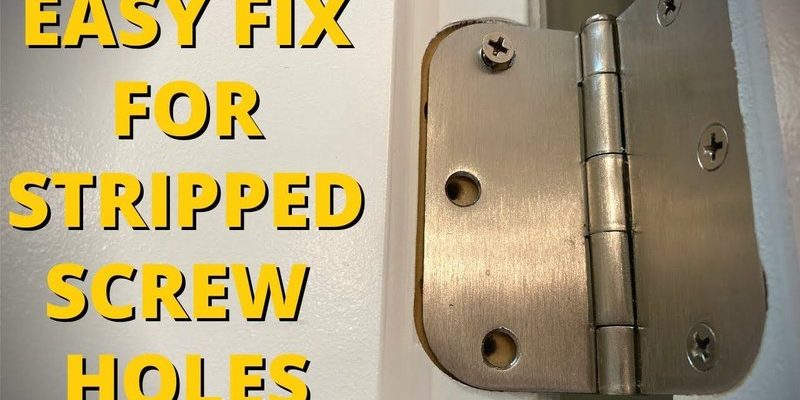
Whether you’re living in an older home or have one that’s seen a lot of love over the years, these issues are surprisingly common. The stress on hinges from opening and closing can lead to stripped holes, making it tough for screws to stay put. Don’t worry; fixing it isn’t as daunting as it sounds. Let’s dive in and explore how you can repair that door frame effectively.
Understanding the Problem with Hinge Screws
When your door is hung, the weight rests on the hinges. Over time, repeated use can cause the screws to become loose or pull out of the frame itself. This is especially true in heavier doors or in areas with fluctuations in humidity and temperature. If the screws don’t grip well, they might just spin in place, leaving you frustrated and your door swinging awkwardly.
You might be wondering why this matters. A properly hanging door not only looks better but also ensures security and functionality. When hinges don’t hold, it can lead to further damage, such as cracks in the door frame or misalignment, making it difficult to open or close the door without forcing it.
Inspecting your hinges regularly can help catch these issues before they worsen. Just like checking your car for strange noises, keeping an eye on your door can save you time and money down the road.
Gathering Your Tools and Materials
Before you start fixing that door frame, it’s a good idea to gather everything you’ll need. Here’s a quick list of tools and materials that will help you tackle this repair:
- Wood glue or epoxy
- Wood filler or toothpicks
- Drill with a drill bit slightly smaller than the screws
- Screwdriver
- Hammer
- Clamps (optional)
- Paint or wood stain (if needed)
You don’t need to be a DIY expert to complete this job. Just make sure you have the necessary tools and materials on hand before you dive in. It’s like preparing for a hike—having the right gear makes the journey a lot smoother.
Assessing the Damage
Once you have your tools ready, it’s time to assess the damage to your door frame. Start by removing the hinge screws one at a time—this way, you can see if the screws themselves are damaged or if the holes in the door frame are stripped.
If the screws come out with little resistance, that’s a sign the holes may need some help. You might notice small cracks or even completely stripped holes where the screw used to fit snugly. This is your cue to get ready for repair.
Take a moment to observe the entire door frame. If multiple screws are loose, you might need to fix each hinge. Treat it like an investigation—checking every angle will help you understand the full picture.
Repairing Stripped Screw Holes
So, what do you do when those screw holes just won’t hold? There are a couple of effective methods to fix this. Here are a couple of options:
1. Wood Filler Method:
– Clean out the hole from any debris.
– Apply wood filler into the stripped hole. Let it dry according to the manufacturer’s instructions.
– Once dried, drill a new pilot hole for the screws. This will give the screws something solid to grip onto again.
2. Toothpick Method:
– Take a few toothpicks and dip them in wood glue.
– Insert the toothpicks into the hole and break them off so they fit snugly.
– Once the glue dries, reinsert the screw into the now more solid hole.
Both methods work well, but if you’re looking for a long-term fix, the wood filler is often the best bet. It’s like reinforcing a weak spot in the wall; once it’s strong again, you can hang that heavy picture with confidence.
Reattaching the Hinges
After ensuring the holes are adequately repaired, it’s time to reattach the hinges. Here’s how to do it smoothly:
– Start by aligning the hinge back onto the door frame.
– Insert the screw into the repaired hole—make sure it’s straight as you tighten it.
– Use a screwdriver to secure the screws firmly, but avoid over-tightening, as this can strip the hole again.
Be patient during this step. Think of it like threading a needle—precision will yield the best results. Tighten each screw incrementally and check the door’s movement frequently.
Final Touches and Preventive Measures
Once your hinges are back in place, step back and check your work. Does the door open smoothly? Is it aligned properly with the frame? If all looks good, you might want to consider some preventive measures to avoid this issue in the future.
Applying a little lubricant to the hinges can help ease any future movement. Additionally, keeping the door frame clean and free from moisture will also prolong its life. Remember, a well-maintained door is your first line of defense against wear and tear.
If you’ve painted or stained the door frame during your repairs, allow it to dry thoroughly before closing the door fully. It’s a waiting game, but trust me—worth it for that perfect finish.
Repairing a door frame where the hinge screws no longer hold may seem daunting at first, but with the right tools, patience, and a step-by-step approach, it’s definitely manageable. Remember, keeping your door functional not only enhances your home’s security but also maintains its aesthetic charm.
With a few simple techniques—from assessing the damage to properly reattaching the hinges—you’re well on your way to a sturdy door that swings just right. So, next time you notice that pesky door acting up, you’ll know exactly what to do. Happy fixing!
